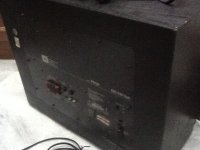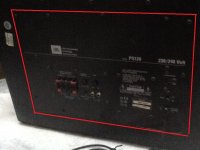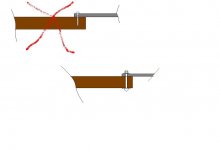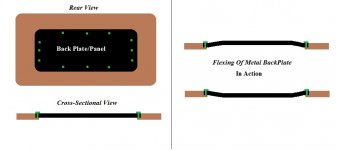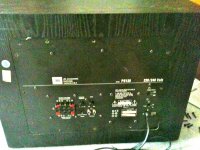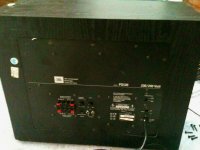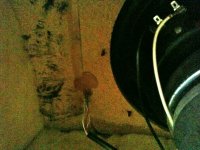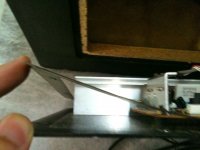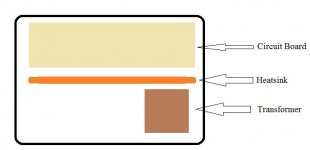I got a very old woofer unit, JBL's PS-120 
This speaker only produce low frequency, range 200hz and below. But it has a fatal problem now ( didn't really notice when it started):
When the bass is very strong, the back panel (removeable steel portion, mark with red frame in picture) which has all the circuit attached except driver, it refuse to stay as a flat piece of metal, STARTED to flex back and forth with the speaker cone This make a loud noise that annoys me.
This make a loud noise that annoys me. 
The noise can be reduce to very low level with my hand press strongly against the back panel, but then I wouldn't able to sit down and enjoy my music/video.
Beside, I couldn't supress it with the strength of hands only I need to use my body weight with my hand to reduce roughly 80-95% of the vibration noise.
I need to use my body weight with my hand to reduce roughly 80-95% of the vibration noise.
So I'm seeking helps from forumers which have knowledge, experience and wisdom to solve this problem.
An externally hosted image should be here but it was not working when we last tested it.
This speaker only produce low frequency, range 200hz and below. But it has a fatal problem now ( didn't really notice when it started):
When the bass is very strong, the back panel (removeable steel portion, mark with red frame in picture) which has all the circuit attached except driver, it refuse to stay as a flat piece of metal, STARTED to flex back and forth with the speaker cone
 This make a loud noise that annoys me.
This make a loud noise that annoys me. 
The noise can be reduce to very low level with my hand press strongly against the back panel, but then I wouldn't able to sit down and enjoy my music/video.
Beside, I couldn't supress it with the strength of hands only
So I'm seeking helps from forumers which have knowledge, experience and wisdom to solve this problem.
Just as extra, I open the back panel before. Maybe due to its old age, it ceiling's soft material aren't stick to it (half fallen) would it be much effect on the sound ?
Or should I say repair/replace it will brings me any benefit of SQ ?
Attachments
Sounds like this is a sealed and not ported sub. Sounds like the rear panel (with amp) is flexing as the air is shifted. I would have thought that if the seal around the amp plate is broken, that this would have made the pressure escape and not flex the panel. Is the panel made of cardboard?
Yeah, it is a sealed woofer, so the amp plate easily move with the cone.Sounds like this is a sealed and not ported sub. Sounds like the rear panel (with amp) is flexing as the air is shifted. I would have thought that if the seal around the amp plate is broken, that this would have made the pressure escape and not flex the panel. Is the panel made of cardboard?
Anyway, it doesn't have any seal around it, just screw directly and side mates with woof/MDF material directly. The panel is made of metal. (normally plated steel I think)
I had rescrew it, make sure it doesn't cause the problem, but still persist. But the thingy I'm sure is that it doesn't have any rubber seal/ring that make it vibration-proof. There is even no washer or that sort of thing. Just directly screw into wood.I don't think the steel plate will be flexing, more likely the screws will be loose.
Hm.... If I put a seal around the panel/plate, then I couldn't reduce it simply ^^ would like to find better solution. Of course I will put back the wool back first ^^ But I think the main problem is not sealing.first stapel/nail the wool back,then put the backplate back wil a seal.
this could be a silecone/rubber or foam seal.
make sure the screws are thight .
Hi, sreten.Hi,
You can reinforce the panel or seal it off from the back pressure.
rgds, sreten.
Seal it off from back pressure ? what does that mean ? do you mean to apply seal, thus possibly it is more affected (flexing) by the air pressure inside ? or make it leak ?
Reinforce is a better way, but is there any method that able reinforcement of the back panel without making degradation of SQ, permanent damage (to the enclosure) ?
In other words, can I make a reinforcement structure that is reversible/safe ? (at least won't harm the woofer)
Regards,
Leong.
Yes, it needs to be resealed but the attachment mechanism isn't working for you (stripping out)..'long term'........
Depending on the stiffness of the electronics " plate" the silly woodscrews have to go. Use thru-bolts with washers & lockwashers. The overlap of the plate should be enough to use a 1/2 " flat washer (Check how much)...have the flat washer, lockwasher, nut on the outside (Duh!)....drill all the way thru...probably 5/8" MDF wood.
When this is all considered........you might consider doubling the amount of screws (Now thru-bolts). Of course it would require you to drill out new holes in the Plate assy.
_______________________________________________________Rick.......
Depending on the stiffness of the electronics " plate" the silly woodscrews have to go. Use thru-bolts with washers & lockwashers. The overlap of the plate should be enough to use a 1/2 " flat washer (Check how much)...have the flat washer, lockwasher, nut on the outside (Duh!)....drill all the way thru...probably 5/8" MDF wood.
When this is all considered........you might consider doubling the amount of screws (Now thru-bolts). Of course it would require you to drill out new holes in the Plate assy.
_______________________________________________________Rick.......
Attachments
Well, your method most of the time only can reduce, but couldn't eliminate the problem. At least in my case, because the wood part that been screw is very thin, less than half a centimeter.Yes, it needs to be resealed but the attachment mechanism isn't working for you (stripping out)..'long term'........
Depending on the stiffness of the electronics " plate" the silly woodscrews have to go. Use thru-bolts with washers & lockwashers. The overlap of the plate should be enough to use a 1/2 " flat washer (Check how much)...have the flat washer, lockwasher, nut on the outside (Duh!)....drill all the way thru...probably 5/8" MDF wood.
When this is all considered........you might consider doubling the amount of screws (Now thru-bolts). Of course it would require you to drill out new holes in the Plate assy.
_______________________________________________________Rick.......
The problem now is with the metal flexing, I think the only way to stop it effectively is to make reinforcement in the middle.
I will take picture (of dismantled) when I get hold of better camera.
Attachments
Yes, it needs to be resealed but the attachment mechanism isn't working for you (stripping out)..'long term'........
Depending on the stiffness of the electronics " plate" the silly woodscrews have to go. Use thru-bolts with washers & lockwashers. The overlap of the plate should be enough to use a 1/2 " flat washer (Check how much)...have the flat washer, lockwasher, nut on the outside (Duh!)....drill all the way thru...probably 5/8" MDF wood.
When this is all considered........you might consider doubling the amount of screws (Now thru-bolts). Of course it would require you to drill out new holes in the Plate assy.
_______________________________________________________Rick.......
Srry for the above post, my memory just blurring up. The MDF wood is just slightly over than 5/8" ^^ but the screw are originally pass through the MDF wood. (metal 2mm thick, screw longer than 1")
I attached some picture. 1st and 2nd picture is the woofer with back panel attached (mounting screw removed)
3rd picture is the internal near the driver. (taken without any intention though) don't know why there is black paint within the box.
4th is backpanel removed, and there is a thin paper-like material sandwiched between wood and metal.
Attachments
i thought the problem was the metal ratling against the wood.
if the elctronics are ratling against the metal,i would sugest to aply some epoxy
between the plate and the part thats rattling against it.
i don't think the metal has become more flexible over time
just my
Will further investigate to make sure which noise that it produce.
If metal ratling against wood, is easy to idenfiy.
But if electronic (or whatever stick to it) is ratling with the metal, then it is hard to distinguish. If I open the back panel, then it will not vibrate.
However, I will take notice of these few point in my testing.
You could put the plate amp in an external box and close the back of the speaker with some proper piece of wood.
Just a thought
Yeah, I have some idea about it before, which is make it ported woofer box, but I will left it as last resort. (wanted to preserve its original sound properties)
Will further investigate to make sure which noise that it produce.
If metal ratling against wood, is easy to idenfiy.
But if electronic (or whatever stick to it) is ratling with the metal, then it is hard to distinguish. If I open the back panel, then it will not vibrate.
However, I will take notice of these few point in my testing.
Hm.... I'm had confirmed that this is not cause by flexing alone. But came from parts attached to the backpanel. When I'm going to suppress the vibration using my hand press against the back panel, first its sound increase in pitch ( some pressing force). If apply alot of force, the the vibration is reduce to inaudible state.
However, this also apply to only some area only (not all area at backpanel can be pressed to reduce the noise. I looked inside, it was somewhere around the transformer ^^ I check all (I really mean all & every) securing mechanism (bolts, buts, etc) and they are firm and secure.
The inside layout is as per attached, the effective press-suppressing area is around the transformer and slightly toward the heatsink. The heatsink is attached to the back panel for better heat dissipation using white colour adhesive.
Any idea how and why it producing noises ? most importantly how to suppress ^^
Attachments
If the amp plate attaching screws are stripped or loose, you can use wood glue to build up the inside of the holes. I've used a big toothpick to get glue into the holes. Don't FILL the holes!!! Just coat the inside of the screw holes. Wait for the glue to dry. That way the screws will have something stronger to bite into.
MLStrand56
MLStrand56
- Status
- This old topic is closed. If you want to reopen this topic, contact a moderator using the "Report Post" button.
- Home
- Loudspeakers
- Subwoofers
- Vibrating nosie from woofer
